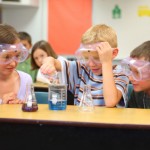Bonus Astronomy Projects!
Thanks so much for joining me for the teleclass! On this page you'll find the videos for the experiments we covered in class, plus a few extras. Enjoy!
Click Here to enroll in e-Science for the upcoming school year AND get all the free bonuses.
Start using it today!
Enroll in the e-Science curriculum starting today, and going for a full year. Includes summer e-Camp, complete Marine Biology course and LOTS more! Full money-back guarantee. Click here to check it out.
Black Hole Bucket
What comes to mind when you think about empty space? (You should be thinking: “Nothing!”) One of Einstein’s greatest ideas was that empty space is not actually nothing – it has energy and can be influenced by objects in it. It’s like the T-shirt you’re wearing. You can stretch and twist the fabric around, just like black holes do in space.
Today, you will get introduced to the idea that gravity is the structure of spacetime itself. Massive objects curve space. How much space curves depends on how massive the object is, and how far you are from the massive object.
Materials:
Pinhole Projector
This is the simplest form of camera – no film, no batteries, and no moving parts that can break. The biggest problem with this camera is that the inlet hole is so tiny that it lets in such a small amount of light and makes a faint image. If you make the hole larger, you get a brighter image, but it’s much less focused. The more light rays coming through, the more they spread out the image out more and create a fuzzier picture. You’ll need to play with the size of the hole to get the best image.
While you can go crazy and take actual photos with this camera by sticking on a piece of undeveloped black and white film (use a moderately fast ASA rating), I recommend using tracing paper and a set of eyeballs to view your images.
Materials:
Plasma Grape
CAUTION!! Be careful with this!! This experiment uses a knife AND a microwave, so you’re playing with things that slice and gets things hot. If you’re not careful you could cut yourself or burn yourself. Please use care!
We’re going to create the fourth state of matter in your microwave using food. Note – this is NOT the kind of plasma doctors talk about that’s associated with blood. These are two entirely different things that just happen to have the same name. It’s like the word ‘trunk’, which could be either the storage compartment of a car or an elephant’s nose. Make sense?
Plasma is what happens when you add enough energy (often in the form of raising the temperature) to a gas so that the electrons break free and start zinging around on their own. Since electrons have a negative charge, having a bunch of free-riding electrons causes the gas to become electrically charged. This gives some cool properties to the gas. Anytime you have charged particles (like naked electrons) off on their own, they are referred to by scientists as ions. Hopefully this makes the dry textbook definition make more sense now (“Plasma is an ionized gas.”)
Black Holes Explorer Game
Created by a team of scientists, you can use this set of instructions to build your own black hole board game. It plays two different ways: competitively and cooperatively. Black Hole Explorer was created for NASA by the Harvard-Smithsonian Center for Astrophysics.
Click the button below to download the game!
Click Here to enroll in e-Science for the upcoming school year AND get all the free bonuses.
Start using it today!
Enroll in the e-Science curriculum starting today, and going for a full year. Includes summer e-Camp, complete Marine Biology course and LOTS more! Full money-back guarantee. Click here to check it out.

